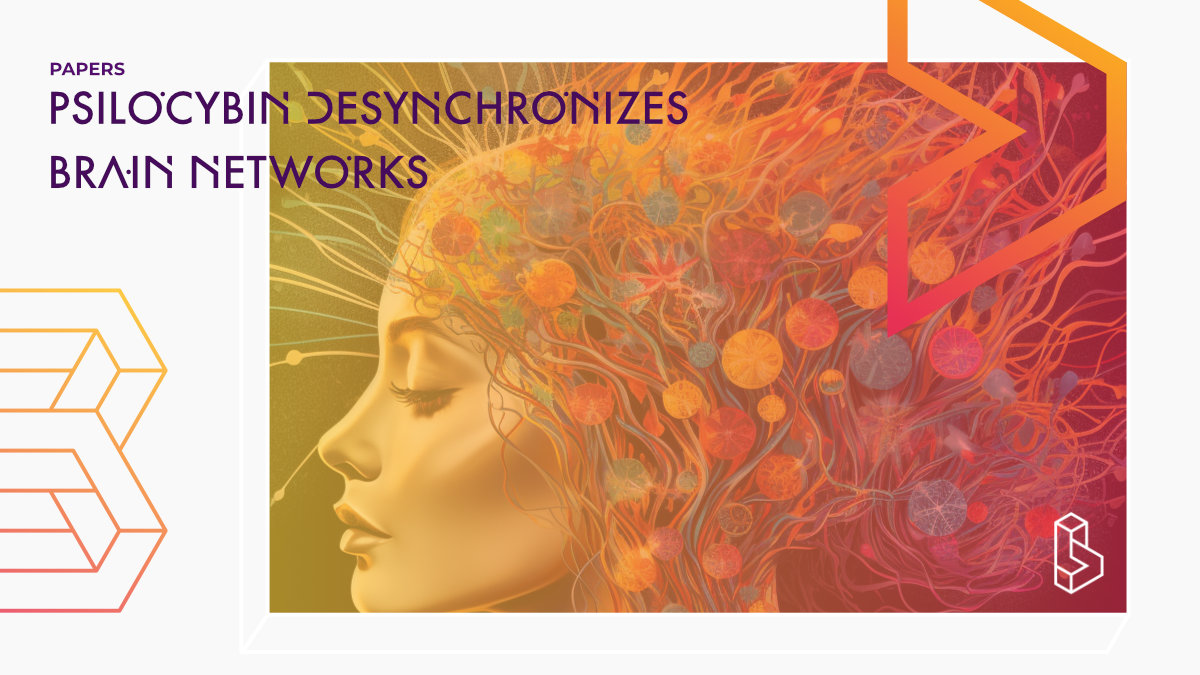This pre-print functional mapping study (n=24) examined brain changes in healthy adults before, during, and up to 3 weeks after taking oral psilocybin (25mg) and methylphenidate (Ritalin), with a follow-up 6+ months later. Psilocybin caused over 3-fold greater acute changes in functional networks than Ritalin, with the most significant disruptions observed in the default mode network (DMN), linked to our sense of self. While a perceptual task reduced these changes, suggesting a way to ground individuals during psychedelic therapy, the acute effects of psilocybin were consistent with distortions of space-time and self. Notably, psilocybin led to a persistent decrease in connectivity between the anterior hippocampus and cortex, especially the DMN, lasting weeks but normalizing after six months, potentially explaining its pro-plasticity and anti-depressant effects.
Abstract of Psilocybin desynchronizes brain networks
“The relationship between the acute effects of psychedelics and their persisting neurobiological and psychological effects is poorly understood. Here, we tracked brain changes with longitudinal precision functional mapping in healthy adults before, during, and for up to 3 weeks after oral psilocybin and methylphenidate (17 MRI visits per participant) and again 6+ months later. Psilocybin disrupted connectivity across cortical networks and subcortical structures, producing more than 3-fold greater acute changes in functional networks than methylphenidate. These changes were driven by desynchronization of brain activity across spatial scales (area, network, whole brain). Psilocybin-driven desynchronization was observed across association cortex but strongest in the default mode network (DMN), which is connected to the anterior hippocampus and thought to create our sense of self. Performing a perceptual task reduced psilocybin-induced network changes, suggesting a neurobiological basis for grounding, connecting with physical reality during psychedelic therapy. The acute brain effects of psilocybin are consistent with distortions of space-time and the self. Psilocybin induced persistent decrease in functional connectivity between the anterior hippocampus and cortex (and DMN in particular), lasting for weeks but normalizing after 6 months. Persistent suppression of hippocampal-DMN connectivity represents a candidate neuroanatomical and mechanistic correlate for psilocybin’s pro-plasticity and anti-depressant effects.”
Authors: Joshua S. Siegel, Subha Subramanian, Demetrius Perry, Benjamin Kay, Evan Gordon, Timothy Laumann, Rick Reneau, Caterina Gratton, Christine Horan, Nicholas Metcalf, Ravi Chacko, Julie Schweiger, Dean Wong, David Bender, Jonah Padawer-Curry, Charles Raison, Marcus Raichle, Eric J. Lenze, Abraham Z Snyder, Nico U. F. Dosenbach &Ginger Nicol
Summary of Psilocybin desynchronizes brain networks
Psychedelic drugs can induce powerful changes in the perception of self, time, and space via the serotonin 2A receptor (5-HT2A receptor) agonism. Acute effects of psilocybin include increased glucose metabolism in the frontal and medial temporal cortex, decreased signal power and functional connectivity, and increased growth of neurons and synapses in vivo and in vitro.
Precision function mapping (PFM) is a method that uses dense repeated rsfMRI to reveal the time course of individual-specific intervention-driven brain connectivity changes. It was applied to study the acute and persistent effects of a single high dose of psilocybin (25mg).
Find this paper
Psilocybin desynchronizes brain networks
https://doi.org/10.1101/2023.08.22.23294131
Open Access | Google Scholar | Backup | 🕊
Cite this paper (APA)
Siegel, J. S., Subramanian, S., Perry, D. A., Kay, B. P., Gordon, E. M., Laumann, T. O., ... & Nicol, G. E. (2023). Psilocybin desynchronizes brain networks. medRxiv, 2023-08.
Study details
Compounds studied
Psilocybin
Topics studied
Healthy Subjects
Neuroscience
Study characteristics
Original
Single-Blind
Within-Subject
Randomized
Participants
24
Humans
Authors
Authors associated with this publication with profiles on Blossom
Charles RaisonCharles "Chuck" L. Raison is an American psychiatrist and professor of psychiatry. Next to his academic affiliation, he is also affiliated with the Usona Institute.
Institutes
Institutes associated with this publication
Washington University School of MedicineLocated in St. Louis Missouri, researchers at the Washington University School of Medicine have conducted a number of studies with psychedelics inlcuding ketamine, psilocybin and nitrous oxide.
Compound Details
The psychedelics given at which dose and how many times
Psilocybin 25 mg | 1xLinked Clinical Trial
Precision Functional Brain Mapping in PsilocybinThis project will employ functional brain imaging to study the mechanism and immediate and long-term effects of psilocybin, a serotonin receptor 2A agonist, on cortical and cortico-subcortical brain networks in healthy adults.

